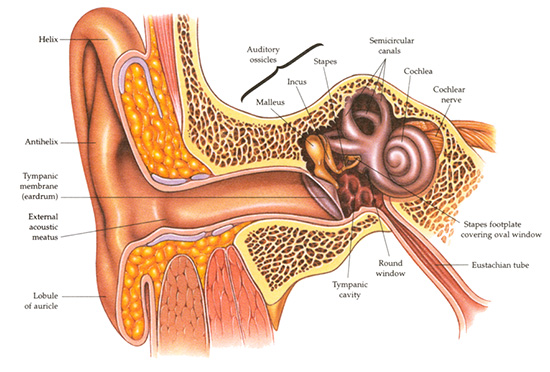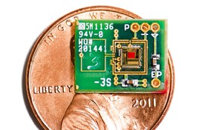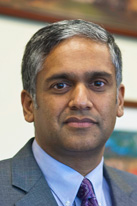| |
Deep inside your ear there is a tiny source of energy that makes human hearing possible. Scientists have known about this energy - known as an endocochlear potential (explained below) - for over 60 years, but until now they have been unable to access it.
Recently, however, a collaborative team involving an ear surgeon and an engineer has shown that the electric potential can be used to power a small electronic device in guinea pigs without interfering with the animal's hearing. This finding could have a large impact on how we diagnose, treat and prevent hearing loss and other problems associated with the inner ear.
To understand how such technology is possible - or even necessary in the first place - let's start with a bit of background on the ear.
The ear is actually a combination of several organs involved in balance and hearing.
It is composed of three distinct parts - the outer, middle and inner ear - that channel the sound waves and convert them into electric impulses that we "hear."
- First, the outer ear - what we know as the ear - gathers sound waves, amplifies them and transmits them to the middle ear.
- In the middle ear, these sound waves are converted into vibrations by three tiny bones. The vibrations are transmitted as waves through fluid into the inner ear.
- There in the inner ear, the waves are then detected by specialized cells, converted into electric impulses, and sent by specialized nerves to the brain as "sound."

Endocochlear Potential
Energy is needed to maintain a constant electrochemical gradient that allows sound to be transmitted. This energy is drawn from an electrochemical potential, known as the endocochlear potential.
Electrochemical potential
Think about this analogy: If you hold a brick up in the air, it has available (potential) energy: if you drop it, that potential will be turned into actual energy when the brick hits the floor and makes a sound and a dent. Electrochemical potential is also a kind of available energy, waiting for an opportunity to do work. In our story, electrochemical potential arises because there are different charges within fluid compartments of the inner ear, creating a flow of electric current as they try to equalize.
Other Applications
The endocochlear potential results from differences in ionic concentrations between two parts of the inner ear which contain fluids with different charges. One fluid, called endolymph, is rich in potassium. The other fluid, perilymph, is high in sodium. [Remember, an ion is an atom or group of atoms with an electric charge, either positive or negative, that results from losing or gaining extra electrons.]
Dr. Konstantina Stankovic, an ear surgeon at the Massachusetts Eye and Ear Infirmary, wondered whether this small source of energy could be harnessed to power electronic devices. To find out, she enlisted the help of Dr. Anantha Chandrakasan, an engineer at the Massachusetts Institute of Technology. Together they developed a small, surgically implantable electronic device that could actually use the energy generated by the endocochlear potential. What would it do? In this case, it would measure the potential's strength: in effect, they developed a minuscule electric meter. While the energy from the endocochlear potential is small, it is the largest source of steady energy found in the human body.
In order for the device to function within the inner ear, the first step was to reduce its energy consumption. The amount of voltage generated by the endocochlear potential is only about 70 to 100 millivolts, which is less than one-tenth the voltage of an AA battery. Most electronic devices require much more energy than produced by the endocochlear potential, so Dr. Chandrakasan and his team simplified the circuits to use a minimal amount of energy. They also developed a tiny meter so that it would become active and use energy only when it was going to take a measurement. The researchers used computer design tools to develop the layout of the implantable chip, the centerpiece of the device. The chip is connected to electrodes on one end and an antenna on the other. The two electrodes are placed into the inner ear to bring energy from the inner ear to the chip. This energy is then used to power the radiotransmitter, which sends information about the electric potential to the external environment. Based on the time needed for the chip to charge between transmissions, the researchers can calculate the strength of the potential.

The implanted device
The Experimental Results
Once Dr. Chandrakasan and his team developed the prototype, Dr. Stankovic and her colleagues implanted the device into the ear of an anesthetized guinea pig. After jump-starting the device with an external power source, the device was able to run for five hours using the electric potential in the inner ear. "This is great proof of concept," Dr. Chandrakasan explains. "We have shown that it is possible to run a small electronic device using the electric potential in the ear without interfering with hearing."
The ultimate goal of this research is to create a device implantable in the human ear to measure the function of the ear and surrounding structures. This information could then be used to study, diagnose and in some cases even prevent hearing loss. To do this, the researchers must first develop a device small enough to be implanted into the human ear. Dr. Chandrakasan would also like to improve the quality of the electrodes that transmit energy from the inner ear to the device.
Dr. Konstantina Stankovic is an Assistant Professor of Otology and Laryngology at Harvard Medical School. She is a practicing ear surgeon at Massachusetts Eye and Ear Infirmary, and her research interests include cochlear implants, hearing loss, and regeneration of the inner ear. When not in the laboratory, Dr. Stankovic enjoys playing music and spending time with her family.
Dr. Anantha Chandrakasan is the Joseph F. and Nancy P. Keithley Professor of Electrical Engineering at Massachusetts Institute of Technology. His current research focuses on the development of low-power biomedical electronics like the device described in this article.
For More Information:
- Mercier, P. et al. 2012. "Energy extraction from the biologic battery in the inner ear." Nature Biotechnology, 30(12): 1240-1244.
- Using the human body to power medical devices. http://on.aol.com/video/using-the-human-body-to-power-medical-devices-517548620
- Harnessing energy from the body to run devices. http://online.wsj.com/article/SB10001424127887324851704578137402753846438.html?mod=wsj_valettop_email
To Learn More:
- Konstantina Stankovic research website: http://www.masseyeandear.org/research/ent/eaton-peabody/epl-investigators/stankovic/
- Anantha Chandrakasan website: http://on.aol.com/video/using-the-human-body-to-power-medical-devices-517548620
- Can blood be used to power batteries? http://electronics.howstuffworks.com/everyday-tech/blood-battery1.htm
- Bio-batteries powered by sugar: http://www.businessweek.com/videos/2012-07-09/bio-batteries-powered-by-sugar
- Sony's bio-battery turns waste paper into electricity: http://www.bbc.co.uk/news/technology-16288107
Written by Rebecca Kranz with Andrea Gwosdow, PhD at www.gwosdow.com
HOME | ABOUT | ARCHIVES | TEACHERS | LINKS | CONTACT
All content on this site is © Massachusetts
Society for Medical Research or others. Please read our copyright
statement — it is important. |
|
|
 Dr. Konstantina Stankovic
 Professor Anantha Chandrakasan
 Dr. Stankovic's laboratory team
 Patrick Mercier, Chandrakasan laboratory team member
 Saurav Bandyopadhyay, Chandrakasan laboratory team member
Sign Up for our Monthly Announcement!
...or  subscribe to all of our stories! subscribe to all of our stories!

What A Year! is a project of the Massachusetts
Society for Medical Research.
|
|

